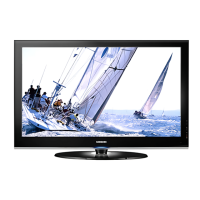Do you have a question about the Samsung PS50A40 and is the answer not in the manual?
Lists contact details for Samsung customer care centers worldwide.
Explains screen image retention/burn-in and how to avoid it.
Covers height limits, heat, cracking noise, and cell defects.
Notes on warranty coverage and installation environment.
Lists main accessories provided with the TV, including ferrite cores.
Lists items sold separately for connecting external devices.
Safe handling and rotation capabilities of the TV stand-base.
Identifies buttons and indicators on the TV's control panel.
Explains the function of each button on the TV's control panel.
Details the various input and output ports on the rear of the TV.
Lists the input and output specifications for EXT 1 and EXT 2.
Explains HDMI/DVI IN ports and ANT IN connector.
Details HDMI IN 3, S-Video/Video/Audio, and Headphones jacks.
Identifies and explains the functions of all remote control buttons.
Buttons for accessing teletext and 3D viewing features.
Guides on how to properly install batteries in the remote control.
Instructions for powering the television on and off.
How to navigate and interact with the TV's on-screen menus.
Steps for setting language, country, and antenna input.
Explains usage modes and recommends Home Use.
Details the auto channel search and clock setting procedure.
How to reset the initial setup process.
Access frequently used functions via the TOOLS menu.
How to switch between different input sources.
Assigning custom names to connected external inputs.
Guides through the automatic channel scanning process.
How to manually tune and store television channels.
Details on Colour System, Sound System, and Channel modes.
How to add specific channels using the Channel Manager.
Enabling Child Lock to prevent unauthorized channel access.
Reordering channels based on program numbers.
How to give custom names to television channels.
Adjusting reception for optimal picture and sound quality.
How to store and reset fine tuning adjustments.
Selecting picture modes like Dynamic, Standard, or Movie.
Adjusting parameters like brightness, contrast, and sharpness.
Accessing advanced options like Gamma and Colour Space.
Fine-tuning color, white balance, and skin tones.
Enhancing object boundaries for clearer image definition.
Choosing display sizes like 16:9, 4:3, Wide Zoom, or Just Scan.
Adjusting screen position and size using the Zoom function.
Selecting screen modes and reducing digital noise.
Samsung's image engine and HDMI black level settings.
Technologies like Pixel Shift to prevent screen burn-in.
Diagram illustrating required connections for 3D viewing.
Optimal settings for pixel shift in 3D mode.
Connecting HDMI, Emitter, and setting PC resolution for 3D.
Activating and switching between 3D modes (Off, Mode1, Mode2).
Choosing Checker Board, Horizontal, or Vertical format for 3D.
How to revert all picture settings to their original defaults.
Selecting sound modes and customizing equalizer settings.
SRS TS XT, Auto Volume, TV Speaker settings.
Controls audio processing for DUAL I-II broadcasts.
How to connect headphones, adjust volume, and safety tips.
Instructions for setting the TV clock and sleep timer.
Setting automatic power on/off times for the TV.
Selecting menu language and power on/off melody.
Adjusting the front LED and selecting entertainment profiles.
Using energy saving modes and displaying PIP.
Configuring PC software and Windows display settings.
Lists resolutions and frequencies for D-Sub PC connection.
Lists resolutions and frequencies for HDMI/DVI PC connection.
Information on interlace mode, video formats, and optimal PC quality.
Automatic adjustment of PC screen for optimal display.
Fine-tuning PC picture quality and resetting to defaults.
Explains Anynet+ as an AV network system for device control.
Diagrams for connecting Anynet+ devices directly or via home theatre.
Steps to enable Anynet+ and set auto turn-off.
How to find, select, and switch between connected Anynet+ devices.
Descriptions of Anynet+ menu items and remote button usage.
How to record TV programs using a connected recording device.
Outputting TV sound through a connected audio receiver.
Solutions for common Anynet+ and device connectivity problems.
Navigating teletext pages and using related remote controls.
Methods to access and understand teletext page structure.
Details on VESA hole patterns, screw sizes, and quantities.
Important safety warnings for installing a wall mount.
Accessing the menu to adjust the auto wall mount position.
Storing and moving the TV to preset positions.
Instructions for attaching the monitor to the stand base.
Warnings for stand assembly and notes on wall mount compatibility.
Steps to secure the TV to the wall to prevent tipping.
Ensuring all connections are secure and checking for fatigue.
Checks for no sound/picture, interference, or color issues.
Troubleshooting remote malfunctions and blinking power lights.
Explains corner screen damage and factory reset messages.
Key technical details of the TV model.
Physical specifications and operating/storage conditions.
Information on responsible disposal of electrical and electronic equipment.
| Aspect Ratio | 16:9 |
|---|---|
| Brightness | 1500 cd/m² |
| Speakers | 2 x 10W |
| Screen Size | 50 inches |
| HD Type | HD Ready |
| Inputs | HDMI, Component, Composite, S-Video |












